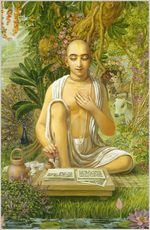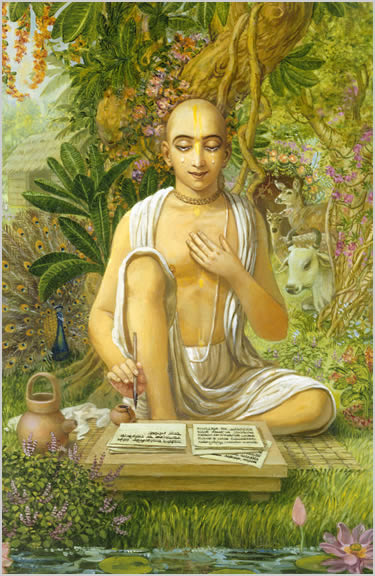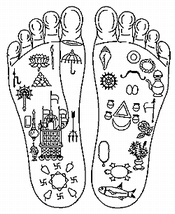


The names of all the Vrajavasi Gosvamis who were living during the time of Sri Mahaprabhu are very well known. Later, after their disappearance, the flow of pure devotion for the Lord took shelter of the three famous Prabhus -- Srinivasa Acarya, Thakura Narottama, and Syamananda Prabhu -- and surged on with full force. In the disciplic succession coming from Thakura Narottama, Sri Visvanatha Cakravarti Thakura appeared in the fourth position.
The story of Sri Visvanatha Cakravarti is more or less known only among the Gaudiya Vaisnavas. They speak of the outstanding excellence of achievement demonstrated by Srila Cakravarti Thakura in his examination of the Srimad Bhagavat and the Bhagavad Gita, as well as his complete understanding of the opinions expressed by the Gosvamis in their own books. Our Thakura is the protector, guardian and acarya of the middle period of Gaudiya Vaisnava dharma's historical development.
Nowadays amongst the Vaisnavas, there is the following saying in relation to Cakravarti Thakura's three most famous books: "kirana bindu kana, e tin niye vaisnava pana" "These three books, Ujjvala-Nilamani-Kirana, Bhakti-rasamrta-sindhu-bindhu, and Bhagavatamrta-kana, are taken and used by the Vaisnavas as their wealth." In this connection, we also hear the following verse sung everywhere:
visvasya natha-ripo 'sauSrila Cakravarti Thakura Defends Sri Narottama's True Position Previously, Srila Narottama Thakura Mahasaya had achieved fame as Rasika-raja, or The King of those devotees who know how to relish the mellows of the topmost madhura-rasa. And he certainly is that. However, certain persons who are envious of Lord Hari -- who are loyal servants of that energy which completely surrounds the fallen souls with strict difficulties -- have dared to attempt to forcibly throw such a wonderful, true rasika as Narottama into their own well of material rasa. Needless to say, they have not been successful. Being unable to understand the purely spiritual activities of Sri Narottama Thakura, many prakrta-sahajiyas had given him the title "Sahajiya-kula-bhusana" (the ornament of the family of cheap imitators). Therefore, Srila Visvanatha Cakravarti Thakura appeared in time to check the spread of this concocted sahajiya mentality, and to truly defend the factual spiritual rank of Srila Thakura Mahasaya.
bhakti-vartma-pradarsanat
bhakta-cakre varttitatvat
cakravarty akhyaya bhavat"Because he has shown the visva-vasis (residents of the material universe) the path of bhakti, he is called 'Visvanatha'; and because he is situated amongst the cakra (circle) of devotees, he is called 'Cakravarti'."
sri rama krsna ganga caran natva gurun uru premnahWe understand from this sloka that Sri Radha-ramana's abbreviated name is 'Sri Rama', and that Sri Krsna-carans's abbreviated name is 'Krsna'. The word 'natha' is understood to mean Sri Lokanatha Gosvami.
srila narottama natha sri gauranga prabhum naumi"Having bowed down while absorbed in the most exalted divine love at the feet of all my gurus in disciplic succession -- Sri Radha-ramana Cakravarti, Sri Krsna-carana Cakravarty, Sri Ganga-narayana Cakravarty, Sri Narottama Thakura and Sri Lokanath Gosvami -- I now offer my respectful obeisances unto my Lord Sri Gauranga Mahaprabhu."
The caste Gosvamis had completely forgotten their own loyalty to the Sri Madhva-sampradaya. Being ignorant of the true facts of the disciplic succession, and being disrespectful to Vaisnava Vedanta, they had fallen into such a degraded condition that Sri Blaldeva Vidya-bhusna was obliged to write a separate commentary on the Vedanta-sutra, according to the philosophy of the Gaudiya-sampradaya. This was done just to refute their false conclusions. Srila Cakravarti Thakura gave his full sanction and approval to this task of counteracting the challenge, which simultaneously resulted in allowing the Gaudiya Vaisnava parampara to continue preaching freely. This event marks the second illustration of Srila Cakravarty Thakura's preaching of the Vaisnava dharma.
Specifically, this is a brilliant example of his endeavor to reform the Vaisnava acaryas who happened to be born in impure brahmana families. Srila Visvanatha Cakravarti Thakura wrote many, many books. The following is a list of as many books as is possible to locate:
2. Samkalpa Kalpa-druma (The Desire Tree of Resolute Determination) 104 Sanskrit verses of prayer to Sri Radhika for the attainment of specific services rendered to Her during the eight periods of the day in Goloka Vrindavana. Often published as a seperate book, this work is included in Sri Visvanatha's collection of prayers called Stavamrta-lahari.
3. Camatkara-candrika (A Moonbeam of Sheer Astonishment) 226 Sanskrit verses in four chapters of short stories depicting Sri Krsna's mischievous pranks conducted in various disguises: 1) Meeting in the Box, 2) Meeting in the Disguise of Abhimanyu, 3) Meeting in the Disguise of a Female Doctor, 4) Meeting in the Disguise of a Female Singer.
4. Prema-samouta (The Jewel -box of Love) 141 Sanskrit verses narrating the story of Krsna coming before Sri Radha in the disguise of a demigoddess, and Radhika's confidential confessions of the innermost core of Her selfless love for Him.
5. Vraja-riti-cintamani (The Touchstone of Life in Vraja) 234 Sanskrit verses in three chapters describing the holy flora, fauna, hills, lakes, groves, temples, and towns of the eternal realm of Vraja.
6. Gauranga-lilamrta (The Nectar of Sri Gauranga's Daily Pastimes) 11 Sanskrit verses depicting Sri Mahaprabhu's daily pastimes conducted in eight periods of the day; the descriptions of the pastimes in each verse are expanded by the extensive Bengali verses composed by Sri Visvanatha's direct disciple, the poet Krsnadasa.
7. Caitanya-rasayana (The Nectar-Tonic of Sri Caitanya) A work that was never finished; the story of it is mentioned in the 13th chapter of Sri Narottama Vilasa by Sri Narahari Cakravarti, the son of Visvanatha's disciple Jagannatha Vipra.
8. Raga-vartma-candrika (A Moonbeam Revealing the Path of Spontaneous Devotion) 22 Sanskrit paragraphs in two chapters of prose and verse which elaborate on the proper behavior and attitudes of one following the path of spontaneous devotional service.
9. Madhurya-kadambini (A Row of Clouds of Sweetness) 8 "showers of nectar" (chapters) of Sanskrit prose which scientifically analyzes the various stages of advancement that one ascends while on the devotional path.
10. Aisvarya-kadambini (A Row of Clouds of Majesty) A work mentioned by Visvanatha in the second chapter of his Madhurya-kadambibi. It is different from the work by Sri Baladeva Vidya-bhusana of the same name. The book by Visvanatha discusses the philosophy of "Dvaitadvaita-vada"; however no copy of this work has ever been found.
11. Ujjvala-nilamani-kirana (One Ray of Sri Rupa Gosvami's Book, Ujjvala-nilamani) 16 paragraphs of Sanskrit prose, composed as a condensed summary study of Srila Rupa Gosvami's 1,453-verse work. It is an examination of the psychology of the Divine Couple's relationship with other and with Their girlfriends.
12. Bhakti-rasamrta-sindhu-bindhu (A Drop From the Nectar-Ocean of Devotion) 27 Sanskrit notes, composed as a summary of Srila Rupa Gosvami's book Bhakti-rasamrta-sindhu, which outlines the process of devotional service.
13. Bhagavatamrta-kana (A Speck of Sri Rupa Gosvami's Book, Laghu-bhagavatamrta) 15 Sanskrit notes that sum up the information presented in Sri Rupa's book, which describes Sri Krsna's various incarnations and plenary portions.
14. Gaura-gana-svarupa-tattva-candrika (A Moonbeam Revealing the Truth of the Identity of Gaura's Associates) A book which follows the earlier work of Sri Kavi Karnapura called Gaura-ganoddesa-dipika. It similarly reveals the Vraja-lila identity of various descendants of the Gaudiya-sampradaya), but is updated to include many other personalities that appeared in the sampradaya after Kavi Karnapura's time.
15. Rupa-cintamani (The Touchstone of Gauranga's Bodily Beauty) Sanskrit verses describing the exact locations of the sacred marks found on Lord Caitanya's palms and soles, including those of Sri Nityananda and Sri Advaita. Visvanatha composed another work also called Rupa-cintamani that describes the head-to-toe beauty of Sri Sri Radha-Krsna, as well as the marks on the soles of Their lotus feet; this work is included in his collection called Stavamrta-lahari.
16. Ksanada-gita-cintamani (The Touchstone of Songs to be Sung at Night) This is the first anthology of devotional songs written by Gaudiya Vaisnava poets in the Bengali, Sanskrit and Braja-bhuli languages. Visvanatha compiled the writings of 45 authors totaling 309 songs, among which are 51 of his own songs, signed with his other pen name Hari-vallabha. The songs are divided up into groups that are to be sung each night of the month; thus there are 30 divisions -- 15 for the dark fortnight and 15 for the light fortnight.
17. Mantrartha-dipika (A Torchlamp Illuminating the Kama-Gayatri Mantra) 18 Sanskrit notes in prose and verse which give detailed explanations of each and every syllable of kama-bija and kama-gayatri mantras. There is also a description of a doubt that Visvanatha had regarding the syllables of the mantra, and how Sri Radhika Herself appeared to him in a dream in order to solve the problem.
18. Stavamrta-lahari (Wave After Wave of Nectarean Prayers) A collection of 28 Sanskrit prayers, astakams, meditations and glorifications.
2. on Bhagavad-gita, named Sarartha-varsini (She Who Showers Forth the Hidden Meanings)
3. on Sri Rupa's Bhakti-rasamrta-sindhu, named Bhakti-sara-pradarsini (She Who Demonstrates the Cream-like Essence of Devotion)
4. on Sri Rupa's Ujjvala-nilamani, named Ananda-candrika (Moonbeams of Pure Bliss)
5. on Sri Rupa's Lalita-madhava-nataka
6. on Sri Rupa's Vidagha-madhava-nataka
7. on Sri Rupa's Dana-keli-kaumudi, named Mahati (She Who Is Glorious)
8. on Sri Rupa's Hamsa-duta
9. on Kavikarnapura's Alankara-kaustubha, named Subhodini (She Who Informs Very Nicely)
10. on Kavi Karnapura's Ananda-vrindavana-campu, named Sukha-varttini (She Who Establishes One in Happiness)
11. on Krsnadasa Kaviraja's Sri Caitanya-caritamrta, which is said to be incomplete.
12. on Narottama dasa Thakur's Prema-bhakti-candrika
13. on Sri Brahma-samhita
14. on Gopala-tapani-upanisad, named Bhakta-harsini (She Who Gives Great Joy to the Devotees)
[From "Sripada Visvanatha Cakravarti Thakur" by Srila Bhaktisiddhanta Saraswati Thakura Prabhupada
and first published in Gaudiya, Volume 18, Number 18, Dated 8 Pausha, Bengali year 1329 (1922 A.D.)

In this painting, Srila Cakravarti Thakura is sitting in Vrndavana, on the banks of the holy lake, Sri Radha-kunda. He is in the midst of writing his commentary on Bhagavad-gita, which is considered the most important basic book for all spiritualists, as it was spoken by Lord Sri Krsna, God Himself. All the details of the painting were told to the artist by Srila Narayana Maharaja, like the peacock-feather pen, the water-pot, the manuscript on the table and so on. Srila Narayana Maharaja even inspired the flowered bowers in the background, and told the artist that the bowers personally decorated themselves. Automatically, without any human assistance, the groves and bowers of the sacred land of Vrndavana decorated themselves.
Srila Cakravarti Thakura appeared in a family of brahmanas in West Bengal, India, about four hundred years ago. He is a great acarya and devotee in the humor of conjugal love with the Lord. He is one of the most important teachers of Krsna consciousness in the disciplic succession coming from Lord Caitanya. He is said to be an incarnation of Srila Rupa Gosvami, who originally established Lord Caitanya's mission of Love of God in this world.
Following in the footsteps of Srila Rupa Gosvami, he composed abundant transcendental literatures about pure devotional service, and thus he also established the inner heart's longing of Sriman Mahaprabhu in this world. He also refuted various faulty conclusions, opposed to the genuine following of Sri Rupa Gosvami (rupanuga). He is thus revered in Gaudiya Vaisnava society as an illustrious acarya and as an authoritative mahajana (self-realized soul). He is renowned as a great transcendental philosopher, poet, and rasika-bhakta.
Srila Visvanatha Cakravarti Thakura has benedicted the whole world by writing the book Madhurya-Kadambini. In reality, Sri Caitanya Mahaprabhu is the speaker of this book. He has spoken it through the mouth of Sri Cakravarti.
The Thakura is very expert in the art of describing extremely complex truths in an easily understandable manner. Among Gaudiya Vaisnava acaryas, there are very few who wrote as many authoritative books he. He is the greatest commentator of Srimad-Bhagavatam, the essence of all the Vedic literature. His three books, Ujjvala-Nilamani-Kirana, Bhakti-Rasamrta-Sinhu-Bindu, and Bhagavatamrta-Kana are taken by the Vaisnavas as their wealth.